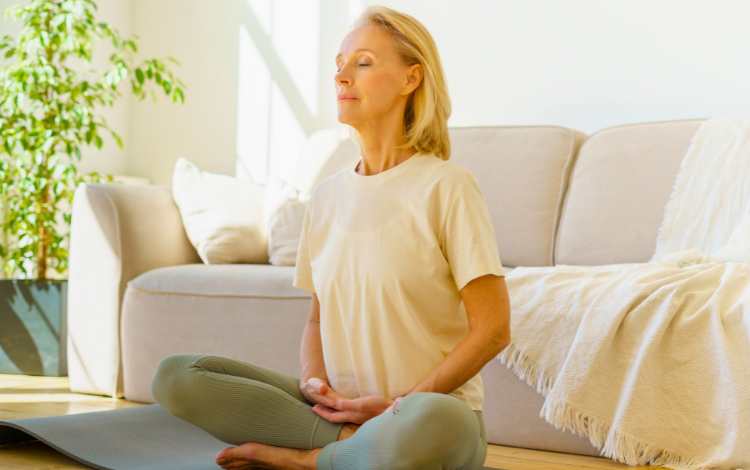
Stress is a normal part of everyone’s life. But with the constant demands of work, family, and personal goals, it can be overwhelming. While it’s the body’s natural response to challenging situations, high stress levels may have adverse effects on your physical and mental health.
Fortunately, there are different ways to alleviate stress. Aside from exercise and spending quality time with loved ones, you can consider various relaxation techniques for stress relief.
Here are some methods that may help calm your mind and body, improving your overall well-being:
1. Deep Breathing and Pranayama
Recommended Resources: Explore our online courses and eBooks on meditation, positive thinking, overcoming procrastination, motivation, affirmations, discipline, focus, and many more topics.
One of the simplest techniques to reduce stress is deep breathing. It involves inhaling deeply through the nose, holding the breath for a few seconds, and then exhaling slowly through the mouth.
This technique helps slow down the heart rate, lower blood pressure, and promote feelings of calm and relaxation.
A more advanced form of deep breathing is called pranayama, which involves controlling the breath in specific ways. While it has similar effects to deep breathing, pranayama may offer additional perks, such as improved focus and increased energy.
To enjoy the benefits of pranayama, it’s crucial to learn from a qualified instructor to ensure safe and correct practice. This is because some of its techniques can be challenging.
Pranayama is often a highly personal experience. An instructor will help you tailor the practice to your individual needs and goals.
2. Progressive Muscle Relaxation (PMR)
Moving from breathwork to bodywork, another effective approach for relieving stress is progressive muscle relaxation. It’s an excellent method to reduce muscle tension, a common stress symptom.
When you tense your muscles, your body releases stress hormones, making you more anxious. PMR can help reverse this process by aiding muscle relaxation. In addition to reducing stress, it may also help enhance your sleep, reduce pain, and improve your overall mood.
To try this technique, start with your toes, tense each muscle group for about five seconds, and then relax for 30 seconds. Repeat this with each muscle group.
When you reach your head, take a few deep breaths, and relax your entire body. You will notice a difference in how you feel after just one session.
3. Mindfulness Meditation
Now that you know the stress-relieving power of progressive muscle relaxation, it’s time to learn mindfulness meditation, the path to inner peace.
This technique can help alleviate stress by allowing your mind to focus on the present moment. By being present and acknowledging thoughts and feelings without judgment, one can achieve a state of relaxation and clarity.
Here are some tips to start practicing mindfulness meditation for stress reduction:
- Find a quiet place where you will not be disturbed.
- Sit in a comfortable position with your back straight.
- Close your eyes and focus on your breathing.
- Notice the sensations of your breath as it enters and leaves your body.
- If your mind wanders, gently bring your attention back to your breath.
- Continue for five to ten minutes.
When done regularly, mindfulness meditation may help decrease your stress levels, improve your mood, and enhance your overall well-being.
If you are unfamiliar with this practice, you can use various resources. You may find websites, apps, and books that offer detailed instructions and other information on how to practice mindfulness meditation.
4. Visualization
Building upon mindfulness practices, you may also wish to try visualization, another potential relaxation technique. Also known as guided imagery, it involves forming mental images to evoke a sense of peace and calm.
Envisioning a soothing scene or situation allows your mind to detach from present stressors, providing a mental escape to tranquility. However, this technique often works best when you incorporate as many senses as possible.
The more senses engaged in the process, the more vivid and immersive the experience. It is not just about seeing an image but truly experiencing it in the mind’s eye.
To practice visualization, find a quiet place where there are no distractions. Close your eyes and imagine your ‘happy place.’ It could be a serene beach, a peaceful forest, or even a favorite childhood spot.
Visualize every detail – the sounds, the smells, and the feel of the place. This will help engage your mind further and deepen the sense of relaxation.

5. Yoga And Tai Chi
Finally, physical activities such as yoga and tai chi can offer stress relief. Both involve performing a series of postures and movements in combination with mindful respiration. These activities enhance physical strength, flexibility, and promote relaxation.
Originating from India, yoga is a practice that incorporates postures, meditation, and breath control to foster a connection between the mind, body, and spirit.
It is more than just physical exercise, providing a space to release tension, quiet the mind, and promote inner peace.
On the other hand, Tai Chi is a Chinese martial art known for its health benefits. It combines slow, graceful movements with deep breathing while focusing on the present moment.
Alongside releasing muscle tension, this gentle practice can also enhance your concentration and reduce stress levels.
These two practices provide a refreshing, holistic approach to stress management. Whether one is a seasoned practitioner or a curious beginner, yoga and Tai Chi can be valuable tools to deal with stress in everyday life.
Final Thoughts
Incorporating these relaxation techniques into daily life can be beneficial in managing stress levels and achieving a healthier, happier life. But remember that what works best may vary from person to person, so feel free to experiment with the different methods.
Moreover, if you are dealing with high levels of stress, seek professional help, as self-help techniques may not always be enough.

